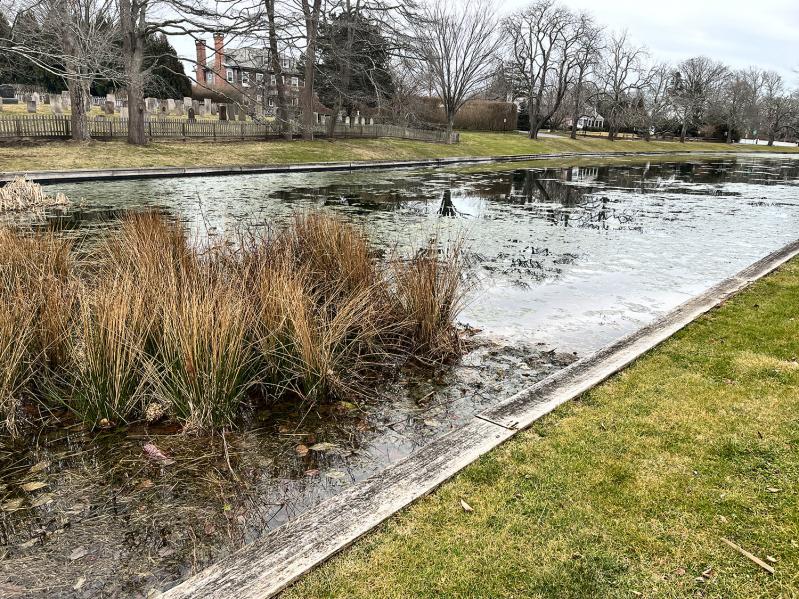Beleaguered Town Pond, low on water, high on invasive plants, was again on the East Hampton Village Board’s agenda Friday, in the form of a resolution providing $9,175 for the “hand removal of surface algae” from the once pristine water body.
James C. Grimes Land Design Inc. will perform the work, at a rate of $65 per hour of work. The proposal assumes it will take a five-man crew three days to complete. Marcos Baladron, the village administrator, said work could begin as early as this week.
“The pond is frustrating, there’s no doubt about it,” commented Mayor Jerry Larsen. “This algae pops up pretty quick. Because we’re having such a warm winter, this weed is growing very rapidly.”
Gloria Frazee, a village resident and founding member of the ReWild Long Island East End Chapter, spoke to the issue during public comment time.
“This is our second time dealing with stuff growing on top of the pond,” she said. “It’s important because the pond is so central to the village. I want to make sure we’re not just making short-term fixes, but that we’re addressing the root problems.” She then thanked the board for taking care of the pond.
Billy Hajek, the village planner, said P.W. Grosser, an engineering firm, was “looking at long-term corrections for multiple issues. One is the amount of water it’s holding, or not holding, and another is the algae problem which is currently occurring in the pond.”
Mr. Baladron said P.W. Grosser was expected to present its suggestions at the board’s next meeting, on March 17.
“We’re pulling out the algae, which is great. Are we looking at controlling what is flowing in?” asked Ms. Frazee.
A recent walk along the bioswale during a rainstorm, she said, allowed her to evaluate the pond’s performance. The bioswale, she said, is “doing really well, slowing the inflow of water so it has a chance to percolate, and catching plastics.” On the library side, however, “You could just see that the drains had flowed massively,” causing heavy erosion. “There’s a lot of stuff flowing in there.”
She suggested planting native plants, specifically blueberries, citing a Vermont campaign, “Buffers for Blue Lakes,” to slow down the flow and help the water percolate into the soil, so it doesn’t flow directly into the pond. “Similar to the bioswale,” she said, adding that “native blueberries, not cultivars, are also great for birds.”
Mr. Hajek explained that the village has no control over the dry wells because they are in the state road right of way. “All of the inlets are completely full,” he said, “to the point where there’s vegetation growing out of them. The storm drains are not doing anything to retain water — it is in their work plan to clean them out — it’s just taking a long time. That will be a huge fix.”
[P.W. Grosser’s] “start date is late summer or early fall,” said David Collins, the superintendent for public works. “They’ll be working from Wainscott to where Town Hall is, cleaning and rebuilding structures.”
“It is amazing that it’s taking this long,” said Mr. Larsen. “It’s just a difficult situation that we can’t control.”
While conceding that the village had no control over the state road, Ms. Frazee offered several possible solutions. The cladophora algae in question eat phosphorus, she explained, and fertilizer from
nearby lawns and septic systems is likely feeding them. She referred to another Vermont campaign, “Don’t ‘P’ On My Lawn,” (“The ‘P’ being the symbol for phosphorus,” she noted) which includes free soil testing for landowners who live in a pond’s watershed.
She suggested the village might do the same.
“In Vermont, they found that 95 percent to 97 percent were way over their phosphorus requirements for a lawn, but they were still applying it. It’s against the law in New York State to use phosphorus on lawns that don’t need it,” she said. “Testing is part of the New York State law. Are we following that?”
“Part of what we can control is educating homeowners, landscapers, and garden centers within the village’s borders, who are selling fertilizers,” Ms. Frazee concluded. “It’s not expensive, and it’s not hard to do.”
“I think it’s a great idea,” said Mayor Larsen.




